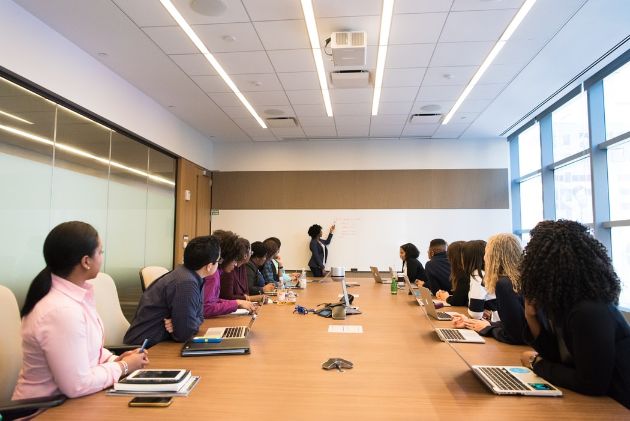What is Conscious Leadership: An Interview with Dr. Lorri Sulpizio
About ten years ago, Brené Brown put vulnerability on the map with her video viral-sensation, The Power of Vulnerability. Since then, she’s written six New York Times Bestsellers, including Dare to Lead in 2018. Today, however, you’re going to read about someone who was shaping vulnerable leaders ten years earlier, under a different label: conscious leadership.
Dr. Lorri Sulpizio is the Director of the Conscious Leadership Academy (CLA) at the University of San Diego (USD). The primary work of the CLA is to shift the leadership paradigm and develop more conscious and aware leaders. Lorri and her CLA team believe that the notion of what a leader is (and how a leader looks) needs to change.
Joined by graduate students and some critical leadership faculty at USD, Lorri and her team have created an approach to leadership development that fosters a more vulnerable approach to leading. Reflection, courage, and connection should be at the forefront of leadership values – not an afterthought.
I had the fortunate opportunity to talk with Dr. Sulpizio to learn more.
What is Conscious Leadership?
Conscious leadership is a leader’s ability to develop a greater awareness of all aspects of their leadership role. This awareness includes understanding the people around them, the deeper issues of the problem, and the context. It also encompasses a well-developed self-awarenessWhy Self-Awareness in Leadership Is Essential for Success; leaders need to understand how their own experiences might be affecting others.
While the full extent of this consciousness is difficult to define, it includes:
- Being self-aware of your own strengths, weaknesses, patterns, and values
- Realizing how your actions affect others (i.e., external self-awareness)
- Understanding the individuals you’re working with and how they’re wired
- Understanding group dynamics and the conscious and unconscious collective
- Recognizing the deeper issues of the challenges at hand
- Recognizing the role that the larger systems and environment play
Dr. Sulpizio compared conscious leadership to the scope of light. Often, leaders only have a small flashlight pointed on the vision. A more effective leader, however, can expand the range with a massive spotlight. By shedding light on the whole arena, they will have a deeper awareness of what’s going on.
“If I’m able to see so much more, then I’m increasing my consciousness. I have more that I’m aware of and attentive to. I not only see the outer world, but my inner world as well. And this doesn’t necessarily mean that I have to act on anything big,” Dr. Sulpizio explains. “However, the wider breadth and depth of awareness is going to help inform how I act, giving me access to more.”
.
Conscious Leaders Have More Options
With a deeper awareness, conscious leaders will have more available options as they decide how to move forward. After all, they have a greater sense of awareness on many levels. They are conscious of all constituents, all sides of the issue, and all the paths to get there.
The need for conscious leadership happens every day. Whether you’re presenting a new idea, troubleshooting a problem, resolving a conflict, or merely performing a daily check-in, you’ll have more pathways to success if you’re more aware.
For example, a conscious leader would notice if she was interrupting her colleagues during a meeting. She might catch herself intervening rapidly in a conversation. She takes a few breaths and then works on her ability to listen to what others are saying.
Conscious leaders are aware of their emotions and recognize when they begin to get triggered. They pay attention to others and attempt to ‘read the room’ to authentically connect with those they are working with.

.
To be a more effective, conscious leader, you might ask yourself:
- What is going on inside me right now?
- How am I reacting to this situation? Is my reaction coming from a centered and grounded place?
- What is being said that is most important?
- Are there other important ideas that are not being voiced?
- Have we heard from everyone in the room? Are we valuing all voices?
- What are the deeper causes behind this issue?
By asking these questions, a leader expands her options beyond the simple course of the quick reactions that most often define us. All of a sudden, many possible courses of action open up tremendously.
.
Three Phrases of Conscious Leadership
Dr. Sulpizio doesn’t just teach conscious leadership, but she uses it in her everyday life. According to her, three phrases establish the foundation for this type of work. And, she says, she reminds herself of them often.
“Self as an instrument.”
Outdated models of leadership considered the “self” as the final, unquestioned authority. Under conscious leadership, the self is a vital part of relating to others. Developing self-awareness is crucial in understanding what’s happening within you as a leader; it’s also necessary to connect to the group.
One’s self-awareness also provides invaluable insight into case studies for the work at hand. While conscious leadership is backed by years of research, some of the most crucial research comes from our inner self-discovery. We can consider previous failures, vulnerable emotions, real-time triggers, and what we learned from them.
All of these experiences provide us with evidence and awareness that can inform our decisions.
“Live in the here and now.”
A large piece of using the self as an instrument involves living in the present moment. This notion of “here and now” (or “Case-in-Point methodology,” as coined first at Harvard) requires leaders to develop their consciousness continuously by working in real-time.
It’s not enough to walk into a room with full awareness of the situation. Conscious leaders must be taking inventory and noticing things as they happen. This means checking in with themselves, with others, and with what’s happening in the room.
Self-awareness and group awareness is a never-ending process, but conscious leadership requires it to be put at the forefront of every occasion.
“I would not ask you to do anything that I wouldn’t do.”
Conscious leaders must do the work that they are asking others to do. This willingness doesn’t just encompass daily tasks (although this notion is important). It also includes living in the here and now – no matter how vulnerable it might feel.
If leaders want their followers to take risks, practice self-awareness, and be honest, they have to be willing to do so themselves. People look to leaders for direction. A conscious leader needs to recognize the directives they give and follow through on them.
.
Dare to Lead: Bringing Vulnerability into Conscious Leadership
Dr. Sulpizio stumbled upon Dr. Brenê Brown at a particularly vulnerable time in her life. Brown’s book Daring Greatly resonated with her powerfully in her personal life. It was then only a matter of time before she began to translate Brown’s work into her professional life.
“There was a very natural progression with Brené Brown’s work on vulnerability and Conscious Leadership,” Dr. Sulpizio explains. “Her research really validated the work we were already doing.”
Dr. Sulpizio became a certified Dare to Lead Facilitator in 2019. Since then, she has utilized some of Brené’s teaching and terms into her leadership work. The growing popularity of vulnerability has also helped her reach more people.
.
3 Steps for How to Develop Self-Awareness for Conscious Leadership
Conscious Leadership centers on one’s ability to develop their self-awareness. And the benefits of self-awareness are astounding. Research has even proven self-awareness to be one of the most significant indicators of success in a leader.
But how does one develop their self-awareness and greater consciousness?

Fortunately, Dr. Sulpizio offered three essential steps to become more conscious leaders.
1. Get curious
As humans, it’s our natural tendency to judge. We need our brains to assess situations, form labels, and categorize situations in our working memory. In doing so, judgment helps us make sense of our complicated world.
The trick, according to Dr. Sulpizio, is to “replace our judgment with curiosity.” Rather than evaluate something and move on, can we be open to more questions and inquiries? The more curious we are, the more we’ll develop a broader awareness of ourselves, others, and the world.
2. Reflect
One’s ability and willingness to reflect is paramount for conscious leadership. We must consider and contemplate past events and actions. Additionally, we’ve got to reflect on our own experiences. This self-reflection allows us to dig into that “case study” evidence to inform our decisions moving forward.
Reflection also opens us up to the different meanings that might be available. Too often, leaders get stuck in the narrow flashlight scope. Reflection can open up the arena more.
3. Hold steady in uncertainty
Many of us pair “leadership” with “action.” However, sometimes leaders need to be able to not act. Conscious leaders must develop their capacity to hold steady in the ambiguity of situations. In doing so, they can develop their consciousness of what’s going on and make better decisions moving forward. They are intentional in their work and mindfulness.
How self-aware are you? Take our free self-awareness test to learn where you might be lacking self-awareness.
.
What’s Getting in the Way of Consciousness
If these steps to develop self-awareness sound easy, they’re not. Self-awareness and consciousness are incredibly challenging for a multitude of reasons.
According to Dr. Sulpizio, one of the biggest obstacles to consciousness is the rigid social standards in our society. Many of us feel “pigeon-holed” into what we should be. These “should be’s” not only limit our ability to lead, but they prevent us from being who we truly are.
Dr. Sulpizio used the term “shackles” to describe just how harmful these social standards can be.
We also need to move past the conventional “leader prototypes” that still exist in our society. Many of us grew up watching authority-driven, non-conscious leaders. Typically, these leaders were male.
The sooner you can break away from this outdated vision, the sooner you can develop more effective leadership traits – like vulnerability, self-awareness, and curiosity. It’s extremely hard to be vulnerable, but it’s necessary to be effective and connected.
.
Conclusion
Conscious Leadership is a leader’s ability to develop a greater awareness of all aspects of their leadership role. By broadening their consciousness, they can more effectively make decisions and open up their options moving forward.
Three essential principles of conscious leadership include the phrases:
- “Self as an instrument”
- “Live in the here and now”
- “I would not ask you to do anything that I wouldn’t do”
Conscious leadership places a strong emphasis on self-awareness as a means for informing their actions and decisions. Unfortunately, things like rigid social standards and lack of representation hold us back on our self-awareness journeys.
To overcome these obstacles, we must take three steps to develop self-awareness and conscious leadership:
- Get curious – turn judgment into inquiry
- Reflect – make reflection a regular part of your routine
- Hold steady in uncertainty – be willing to pause and consider before taking action
Read more about Dr. Sulpizio and her Conscious Leadership work below.
.
About Dr. Lorri Sulpizio
Dr. Lorri Sulpizio is the Director of Conscious Leadership Academy, a program at the University of San Diego’s School of Leadership and Education Sciences. She also founded and serves as CEO of the Lotus Leadership Institute, an organization dedicated to developing and transforming leaders and institutions. She also oversees the Center for Women’s Leadership at San Diego and advisees multiple organizations and initiatives.
Dr. Sulpizio has studied and practiced leadership throughout her career. She began her career as a head women’s basketball coach before moving toward the educational side of leadership. She has her Ph.D. in Organizational Leadership and her MA in Sports Psychology.
To learn more about her work and what she can offer you, check out her blog, or explore how to work with Lorri around developing your leadership capacity.
.



